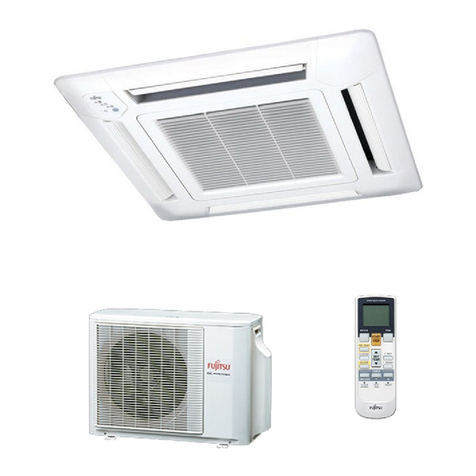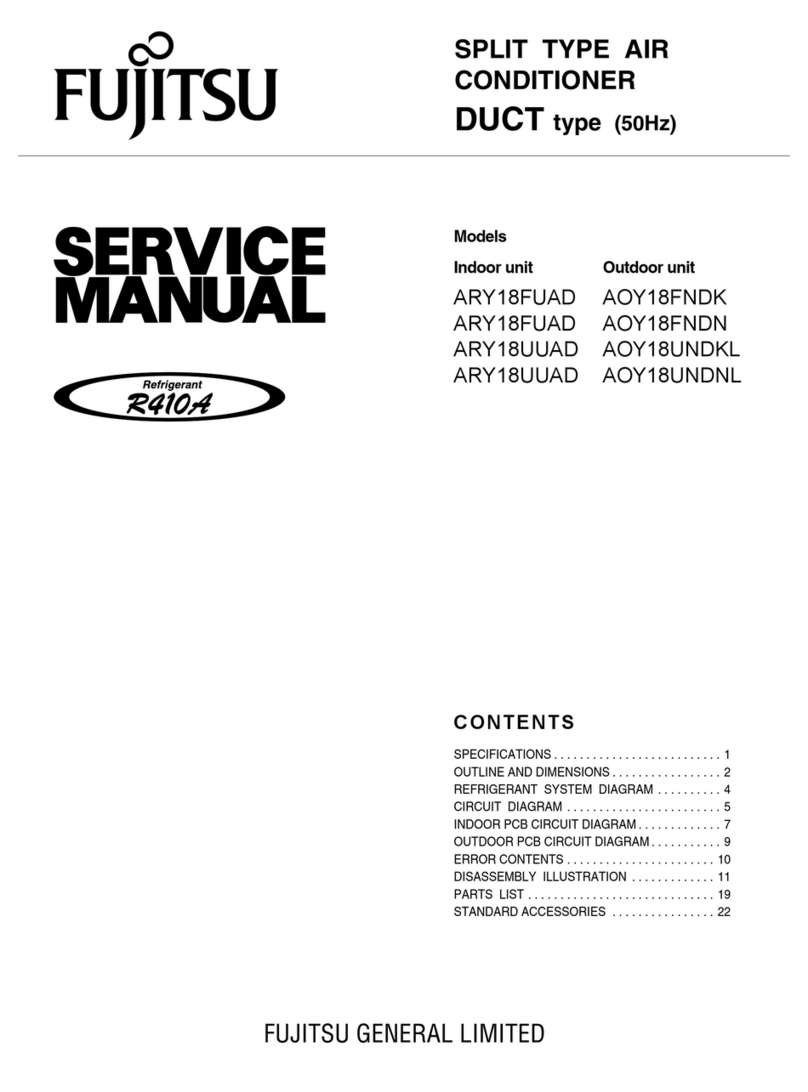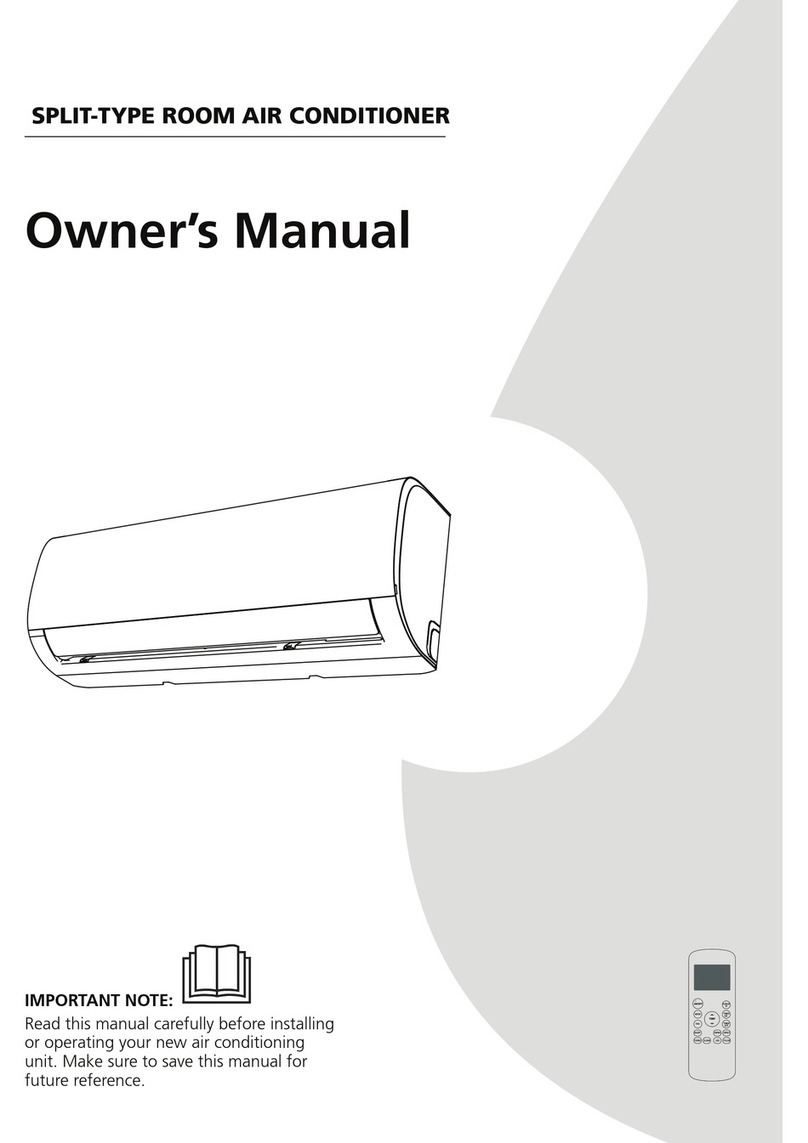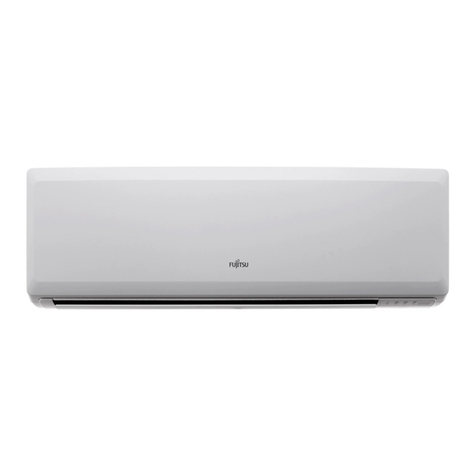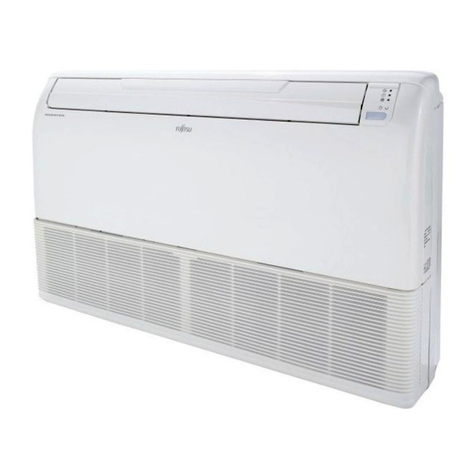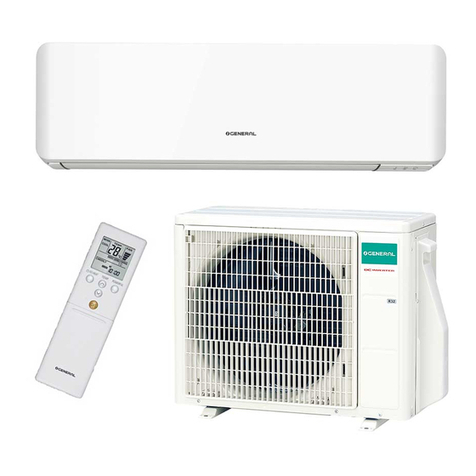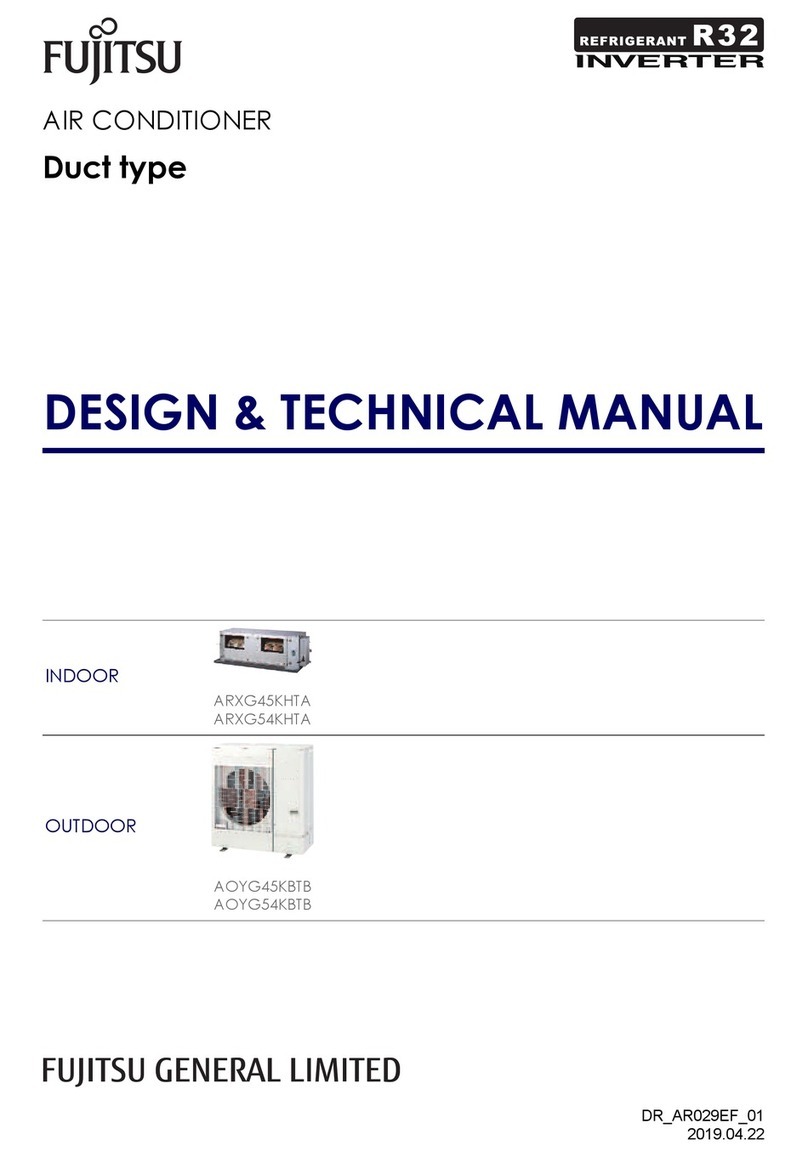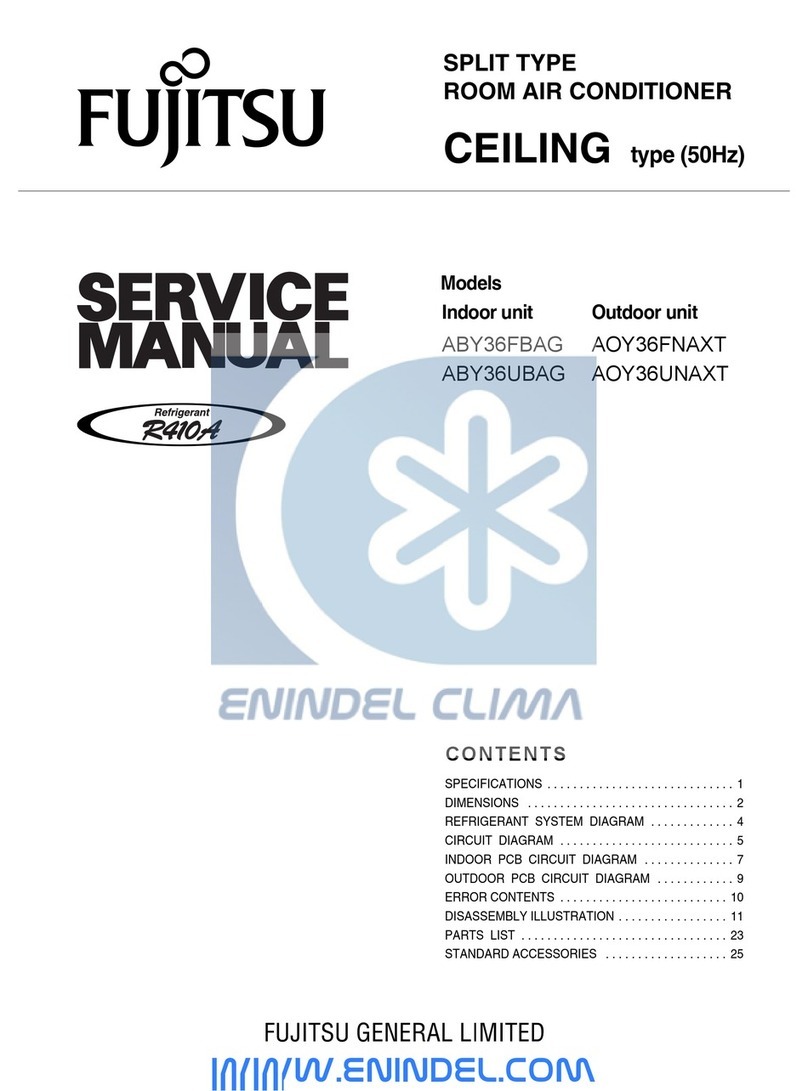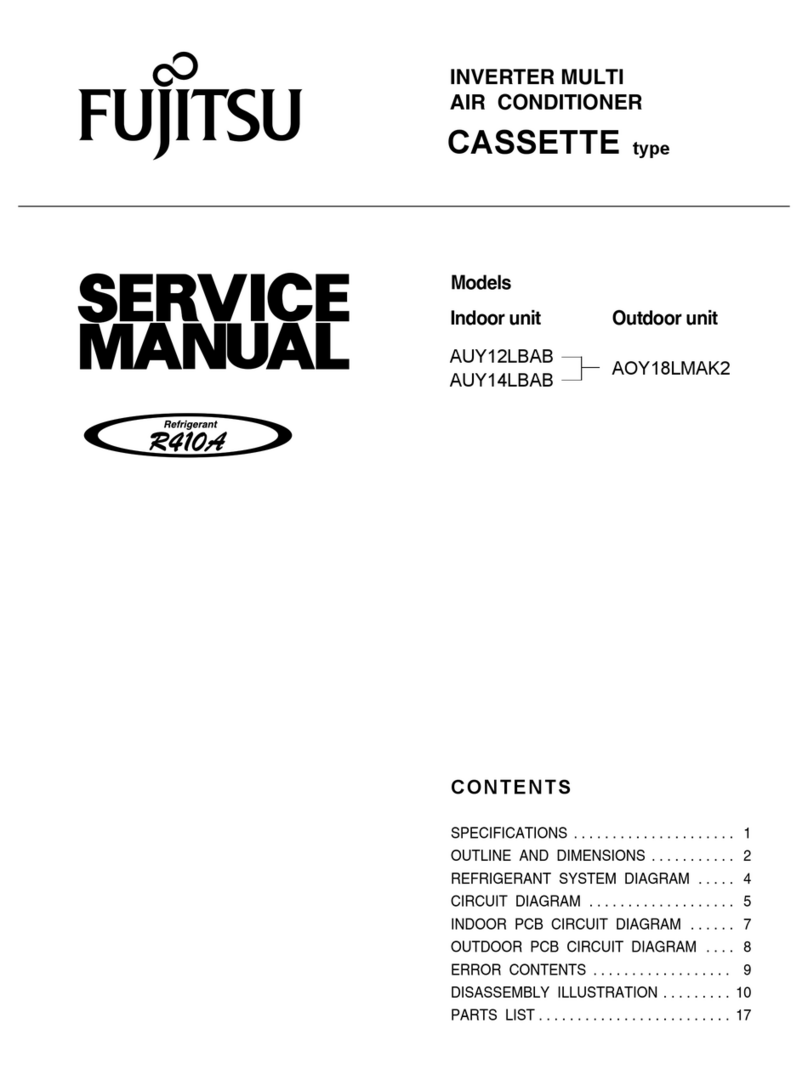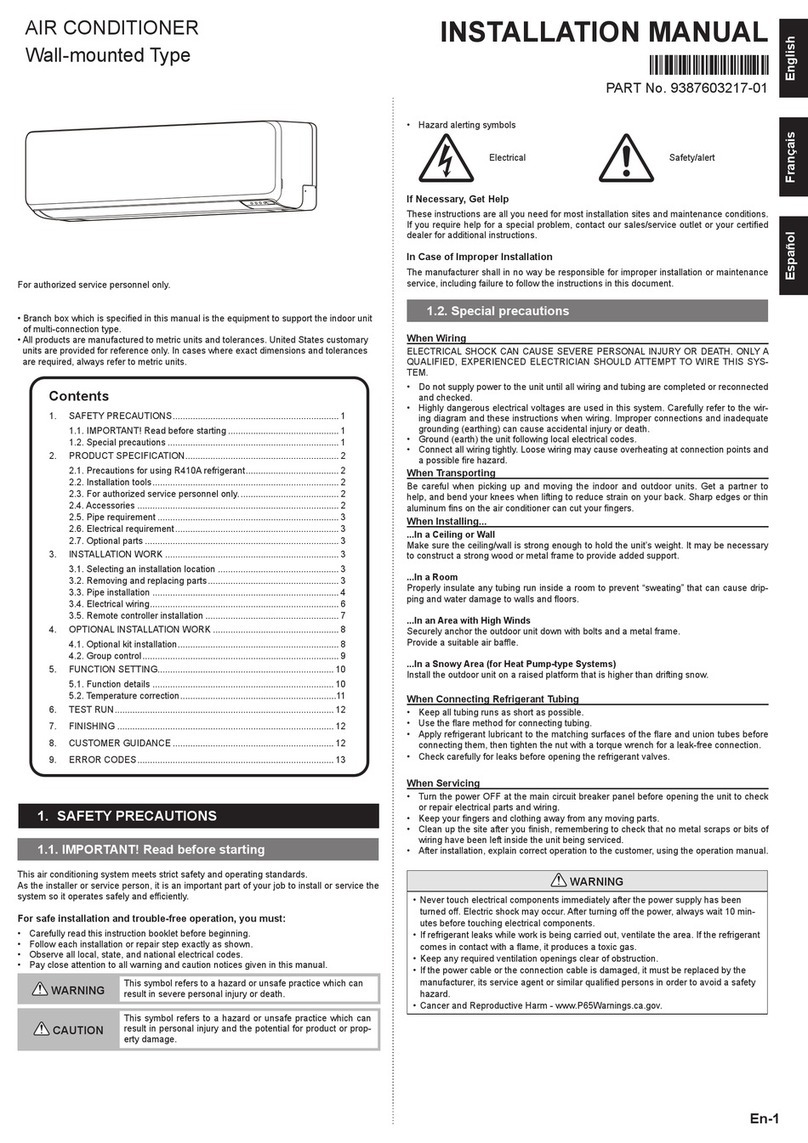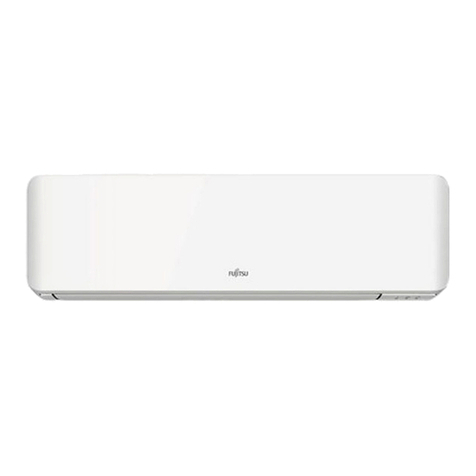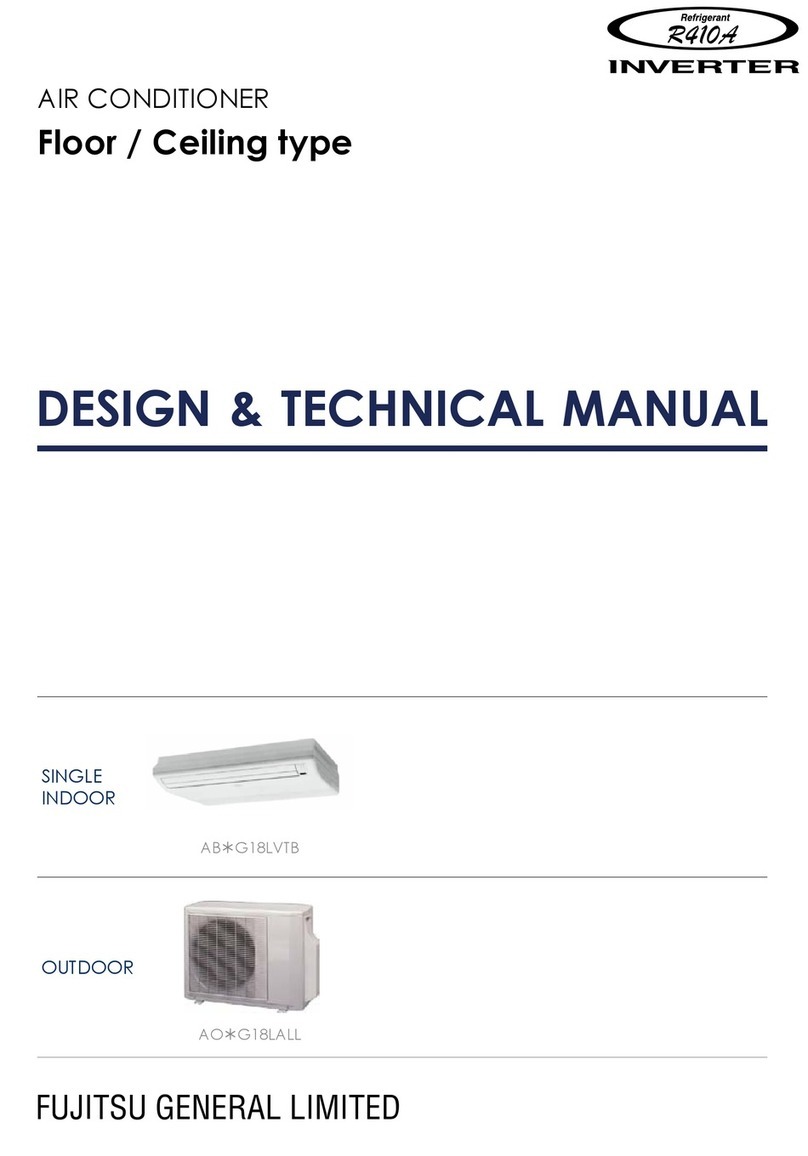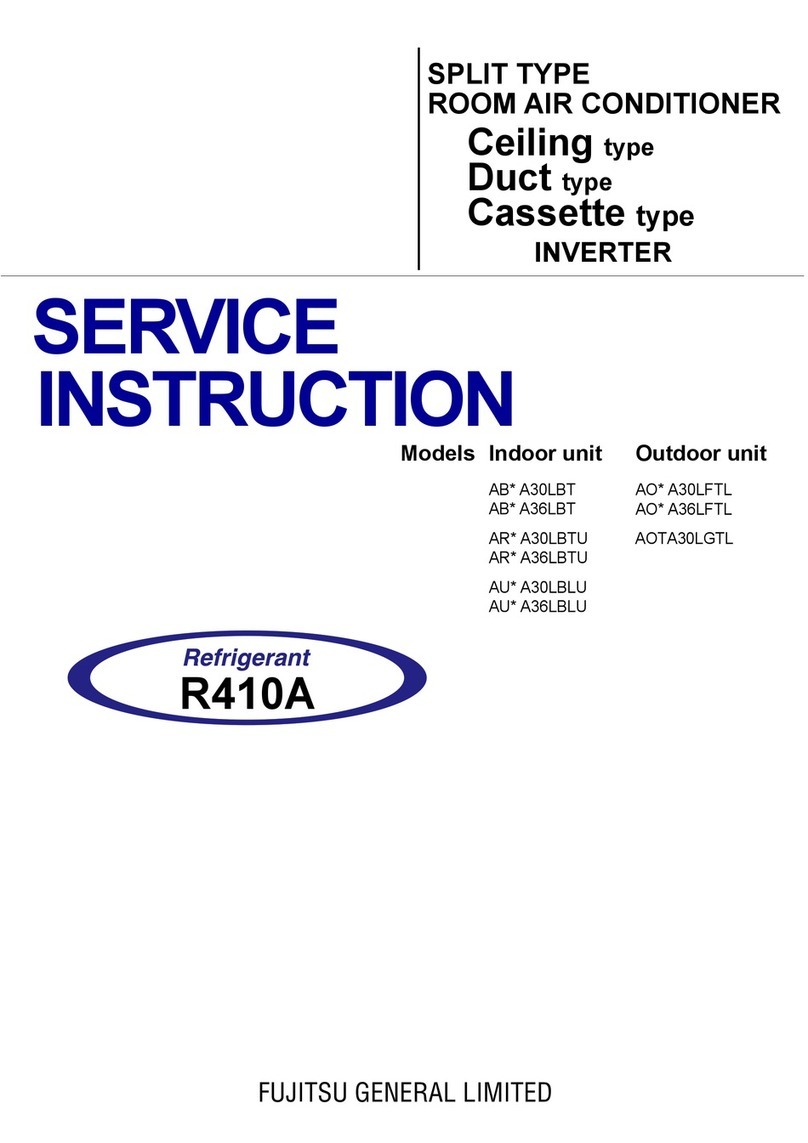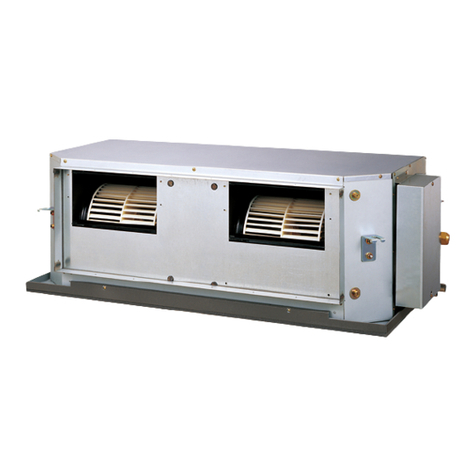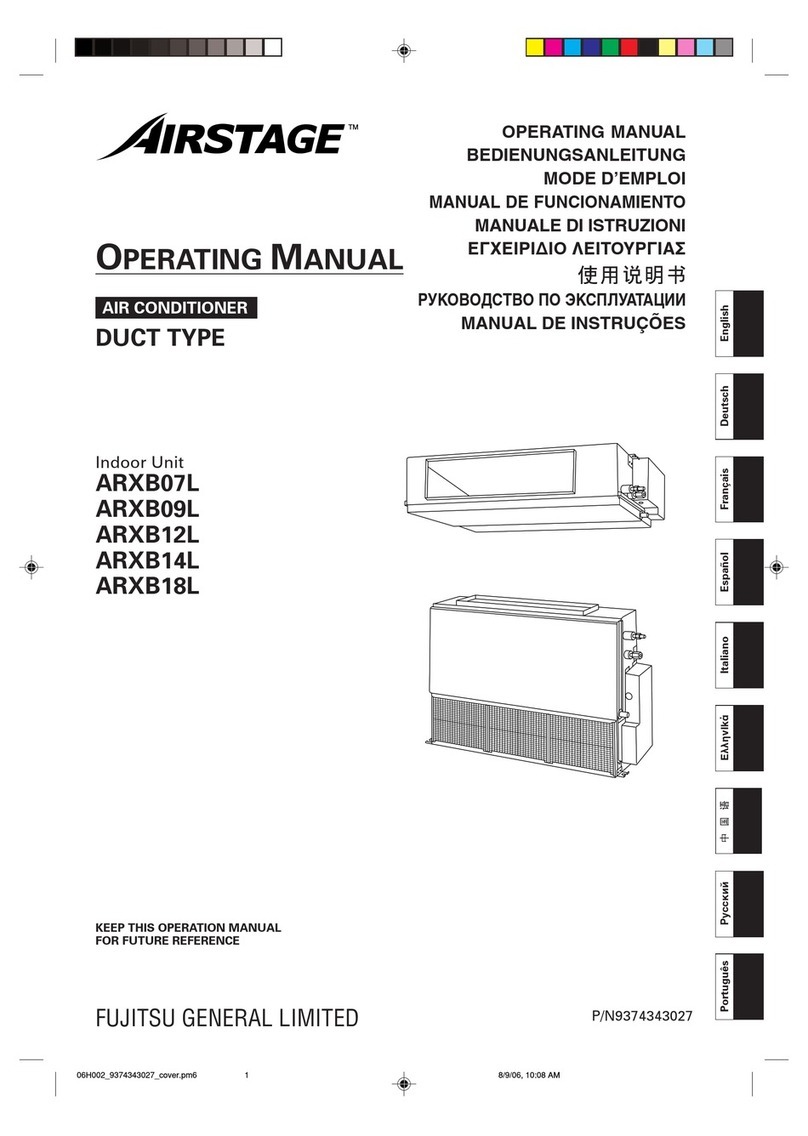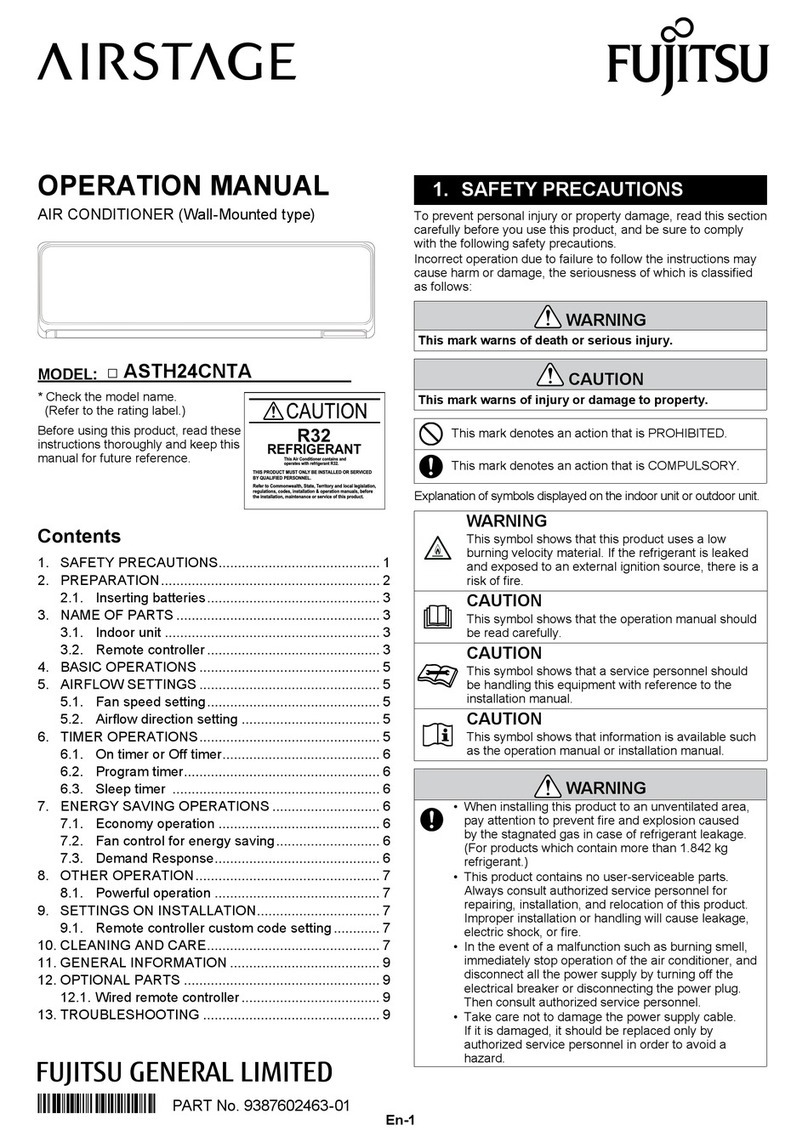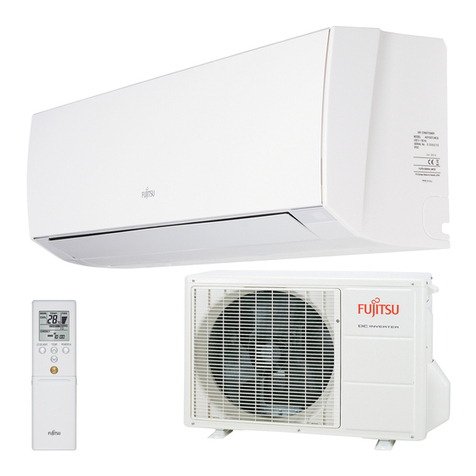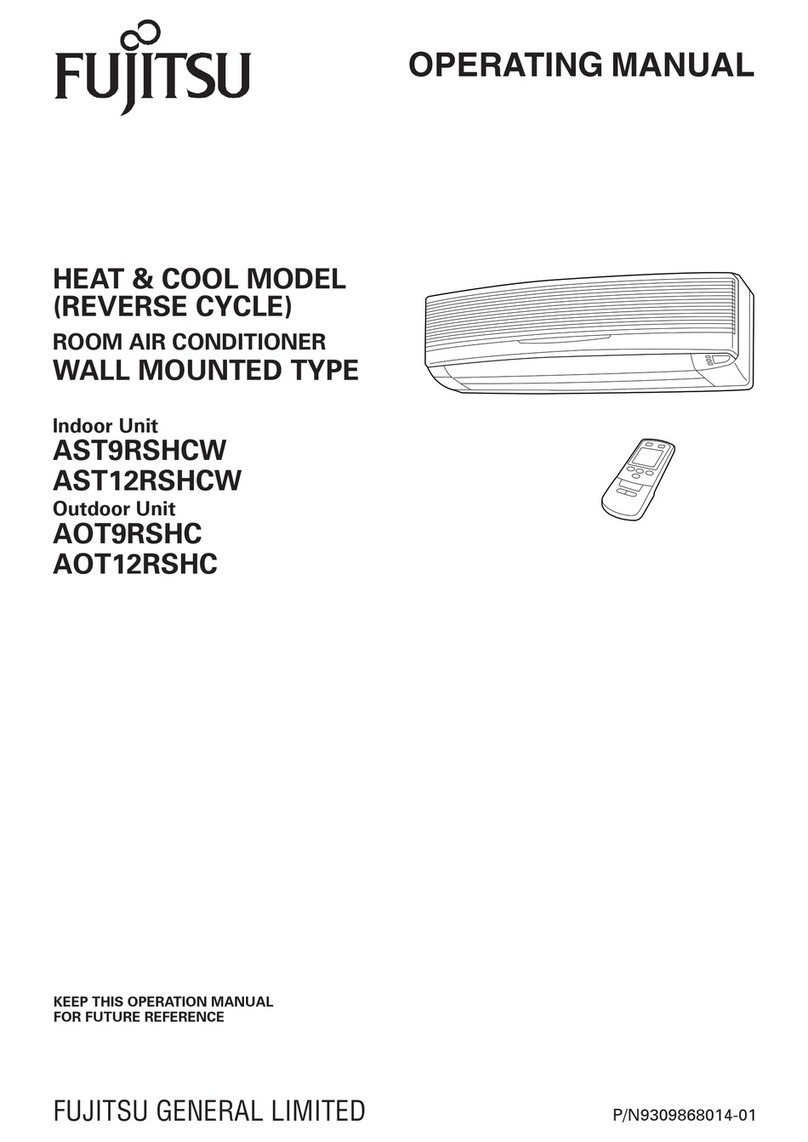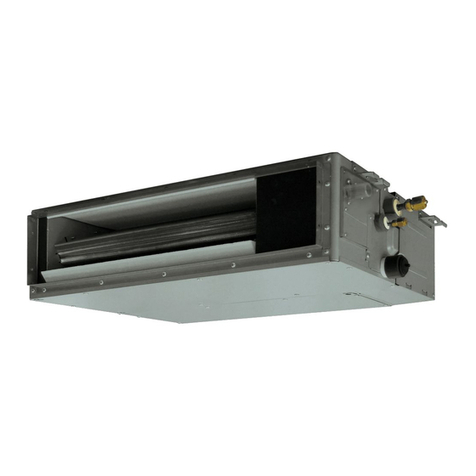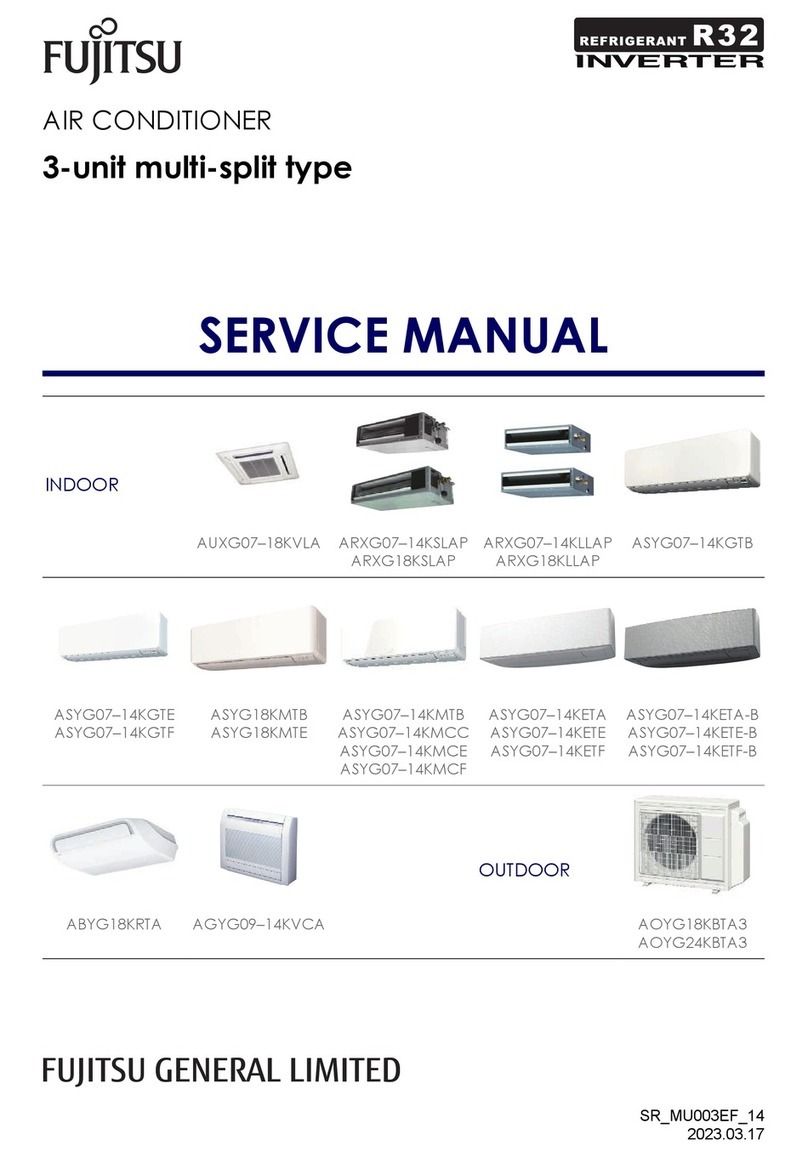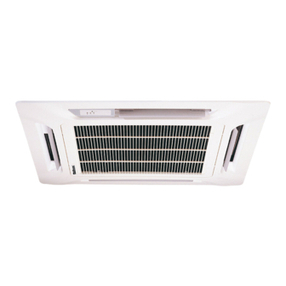For authorized service personnel only.
(1) For the room air conditioner to operate satisfactory, install it as outlined in this installation manual.
(2) Connect the indoor unit and outdoor unit with the air conditioner piping and cords available standards parts. This
installation manual describes the correct connections using the standard accessories and the parts specified in
this installation manual.
(3) Have installation work done by authorized service personnel only.
(4) Also do not use an extension cord.
(5) Do not turn on the power until all installation work is complete.
WARNING
●Be careful not to scratch the air conditioner when handling it.
●After installation, explain correct operation to the customer, using the operating manual.
●Let the customer keep this installation manual because it is used when the air conditioner is serviced or moved.
STANDARD ACCESSORIES
The following installation accessories are supplied.
Use them as required.
Name and Shape Q’ty Name and Shape Q’ty
Connection pipe assembly
Connection cord
Wall pipe
Decorative tape
Vinyl tape
Wall cap
Saddle
Drain hose
Tapping screws
Sealant
Name
Wall hook bracket
Remote
control
unit
Battery
Tapping screw (big)
Cloth tape
1
1
2
One set of following parts are necessary in installation of this
product.
ELECTRICAL REQUIREMENT
Always make the air conditioner power supply a special branch circuit
and provide a special switch and receptacle. Do not extend the power
cord.
• Electric wire size.
• Install the disconnect device with a contact gap of at least 3 mm
nearby the units. (Both indoor unit and outdoor unit)
• Always make the air conditioner power supply a special branch
circuit and provide a special breaker.
• Use conformed cord with Type245 IEC57.
• Install all electrical works in accordance to the standard.
• Before starting work, check that power is not being supplied to all
poles of the indoor unit and outdoor unit.
1
9
2
Tapping screw (small)
Air cleaning filter
2
Remote control
unit holder
1
9,000 ~14,000 BTU class
1.5
MODEL
Connection cord (mm2)
Function
number
Setting
value
Decide the mounting position with the customer as follows:
(1) Install the indoor unit level on a strong wall which is not subject to
vibration.
(2) The inlet and outlet ports should not be obstructed : the air should
be able to blow all over the room.
(3) Install the unit near an electric outlet or special branch circuit.
(4) Do not install the unit where it will be exposed to direct sunlight.
(5) Install the unit where connection to the outdoor unit is easy.
(6) Install the unit where the drain pipe can be easily installed.
(7) Take servicing, etc. into consideration and leave the spaces shown
in (Fig. 1). Also install the unit where the filter can be removed.
(8) Install the place where is no gap around the unit.
WARNING
Install at a place that can withstand the weight of the
indoor and install positively so that the units will not
topple or fall.
CAUTION
(1) Do not install where there is the danger of com-
bustible gas leakage.
(2) Do not install near heat sources.
(3) If children under 10 years old may approach the
unit, take preventive measures so that they can-
not reach the unit.
SELECTING THE MOUNTING
POSITION
[Indoor unit piping direction]
The piping can be connected in the six directions indicated by 1,
2, 3, 4, 5and 6in (Fig. 2). When the piping is connected in
direction 2or 5, cut along the piping groove in the side of the
base with a hacksaw.
When connecting the piping in direction 3, 6cut a notch in the thin
wall at the front bottom of the base.
INSTALLATION DIAGRAM OF
INDOOR UNIT
Fig. 1
[INDOOR UNIT]
Fig. 2
1Right
rear
outlet
2Right
outlet
3Right
bottom
outlet
4Left rear
outlet
5Left
outlet
(Rear)
SIDE PANEL L, R REMOVAL AND INSTALLATION
Fig. 4
THE INTAKE GRILLE REMOVAL
(1) Open the intake grille.
(2) Remove the rope.
(3) Lay down the intake grille, until the axle at the bottom of the
intake grille is removed.
THE INTAKE GRILLE INSTALLATION
(1) The fixing axle of the intake grille is installed on the Panel.
(2) Lift the intake grille upward.
THE SIDE PANEL L, R REMOVAL
(1) Remove intake grille (Reference the intake grille removal.)
(2) Remove four screws.
(3) The middle finger is hung on the lower part as shown in the
figure, and it pulls to the front, pushing [컅] mark , and bottom
hooks (two position) is removed from Base.
(4) The side panel is pulled to the front, raising the upper surface,
and a side panel is removed.
THE SIDE PANEL L, R INSTALLATION
(1) Firstly, fit the top part of the side panel, and insert top and bot-
tom hooks.
(2) Four screws is attached.
(3) The intake grille is attached.
Installation instruction on the back.
Explain the following to the customer in accordance with the operat-
ing manual:
(1) Starting and stopping method, operation switching, temperature
adjustment, timer, air flow switching, and other remote control
unit operations.
(2) Air filter removal and cleaning, and how to use the air louvers.
(3) Give the operating and installation manuals to the customer.
CUSTOMER GUIDANCE
6Left
bottom
outlet
Remote
control unit
Connection Cord
Conform to Type245 IEC57
OUTDOOR UNIT
Tapping
screw
(small)
Remote
control unit
holder
10 cm or over
8 cm or over
(Wall cap)
8 cm or over
5 cm or
over
Mounting shaft
Front panel
Intake grille
Screw
BASE
SIDE
BASE
SIDE PANEL R
Intake grille
ROPE Front panel
ROPE
SIDE PANEL L
SIDE PANEL R
[컅] Mark
POWER
CAUTION
(1) The power source capacity must be the sum of the air conditioner current and the current of other electrical appliances. When the
current contracted capacity is insufficient, change the contracted capacity.
(2) When the voltage is low and the air conditioner is difficult to start, contact the power company the voltage raised.
WARNING
(1) The rated voltage of this product is 230 V AC 50 Hz.
(2) Before turning on the power, check if the voltage is within the
220 V -10 % to 240 V +10 % range.
(3) Always use a special branch circuit and install a special
receptacle to supply power to the room air conditioner.
(4) Use a circuit breaker and receptacle matched to the capacity of
the air conditioner.
(5) Do not extend the connection cord.
(6) Perform wiring work in accordance with standards so that the
air conditioner can be operated safely and positively.
(7) Install a leakage circuit breaker in accordance with the related
laws and regulations and electric company standards.
CAUTION
Install the SIDE PANEL L, R
and INTAKE GRILLE securely.
If installation is imperfect, the
SIDE PANEL L, R or INTAKE
GRILLE may fall off and cause
injury.
EMBEDDING THE INDOOR UNIT IN A WALL
●When installing a grating, use a grating with narrow upper and lower
horizontal bars so that the airflow from the upper and lower air outlets
does not contact the bars. If the horizontal bars will block the lower
air outlet, use a stand, etc., to adjust the height of the indoor unit. If
the upper or lower air outlet is blocked, the air conditioner will not be
able to cool or warm the room well.
●Do not block the receiver with the grating. Otherwise, the grating will
interfere with the remote controller signal and significantly reduce
the distance and area (angle) from which the signals can be received.
●Use a grating with vertical bars, etc., that has at least 75% open area.
If the grating has horizontal bars or if the open area is less than 75%,
performance could be reduced.
●When the indoor unit is embedded in a wall (built-in), the time it takes
for the room temperature to reach the set temperature will increase.
Fig. 3
Upper air outlet
8 cm or more
Lower air outlet
8 cm or more
Grating Indoor
unit
10 cm or
more
2 ~ 3 cm
When embedding the indoor unit in a wall, restrict the movement of the horizontal vane for the upper air outlet so that it only operates horizontally.
If this setting is not performed, heat will build up in the wall and the room will not be cooled or warmed properly.
Please explain the vane setting of direction only horizontally to the customer.
HOW TO SETTING VANE
Perform the "FUNCTION SETTING" according to the installation condition using the remote controller.
Entering the Function Setting Mode
1While pressing the FAN button and SET TEMP simultaneously, press the RESET button to enter the function setting mode.
2Press the TIMER MODE button two times and check that the indoor unit can receive signal.
3Selecting the function number and setting value.
(1) Press the SET TEMP. button to select the function number.
(Press the MODE button to switch between the left and right digits.)
(2) Press the FAN button to poceed to setting the value.
(Press the FAN button again to return to the function number selection.)
(3) Press the SET TEMP. button to serect the setting value.
(Press the MODE button to switch between the left and right digits.)
(4) Press the TIMER MODE button, and START/STOP button, in the order listed to confirm the settings.
(5) Press the RESET button to cancel the function setting mode.
(6) After completing the FUNCTION SETTING, be sure to turn off the power and turn it on again.
FUNCTION
SETTING
23
SETTING
VALUE
2
15 cm or below
from the floor
SPLIT TYPE ROOM AIR CONDITIONER
INSTALLATION MANUAL
(PART No. 9378533011)
The basic installation work procedures are the same as conventional refrigerant (R22) models.
However, pay careful attention to the following points:
(1) Since the working pressure is 1.6 times higher than that of conventional refrigerant (R22) models,
some of the piping and installation and service tools are special.(See the table below.)
Especially, when replacing a conventional refrigerant (R22) model with a new refrigerant R410A
model, always replace the conventional piping and flare nuts with the R410A piping and flare nuts.
(2) Models that use refrigerant R410A have a different charging port thread diameter to prevent
erroneous charging with conventional refrigerant (R22) and for safety. Therefore, check
beforehand.[The charging port thread diameter for R410A is 1/2 threads per inch.]
(3) Be more careful that foreign matter (oil, water, etc.) does not enter the piping than with refrigerant
(R22) models. Also, when storing the piping ,securely seal the opening by pinching ,taping, etc.
(4) When charging the refrigerant, take into account the slight change in the composition of the
gas and liquid phases, and always charge from the liquid phase side whose composition is
stable.
This air conditioner uses new refrigerant HFC (R410A).
Special tools for R410A
Tool name
Gauge manifold
Charge hose
Vacuum pump
Gas leakage detector
Contents of change
Pressure is high and cannot be measured with a conventional gauge. To prevent erroneous
mixing of other refrigerants, the diameter of each port has been changed.
It is recommended the gauge with seals-0.1 to 5.3 MPa (-1 to 53 bar) for high pressure.
-0.1 to 3.8 MPa (-1 to 38 bar) for low pressure.
To increase pressure resistance, the hose material and base size were changed.
A conventional vacuum pump can be used by installing a vacuum pump adapter.
Special gas leakage detector for HFC refrigerant R410A.
Copper pipes
It is necessary to use seamless copper pipes and it is desirable
that the amount of residual oil is less than 40 mg/10m. Do not
use copper pipes having a collapsed, deformed or discolored
portion (especially on the interior surface). Otherwise, the ex-
pansion value or capillary tube may become blocked with
contaminants.
As an air conditioner using R410A incurs pressure higher than
when using R22, it is necessary to choose adequate materials.
Thicknesses of copper pipes used with R410A are as shown in Table1.Never us copper pipes thinner than 0.8mm even
when it is available on the market.
Table 1 Thicknesses of Annealed Copper Pipes
Thickness (mm)
Nominal
diameter
1/4
3/8
1/2
Outer diameter
(mm)
6.35
9.52
12.7
R410A
0.80
0.80
0.80
[ref.] R22
0.80
0.80
0.80
CAUTION
When installing pipes shorter than 3m, sound of the outdoor unit will be transferred to the indoor unit, which will
cause large operating sound or some abnormal sound.
(1) Do not use the existing (for R22) piping and flare nuts.
• If the existing materials are used, the pressure inside the refrigerant cycle will rise and cause breakage, injury,
etc.(Use the special R410A materials.)
(2) When installing and relocating the air conditioner, do not mix gases other than the specified refrigerant(R410A)
to enter the refrigerant cycle.
• If air or other gas enters the refrigerant cycle, the pressure inside the cycle will rise to an abnormally high value
and cause breakage, injury, etc.
WARNING
